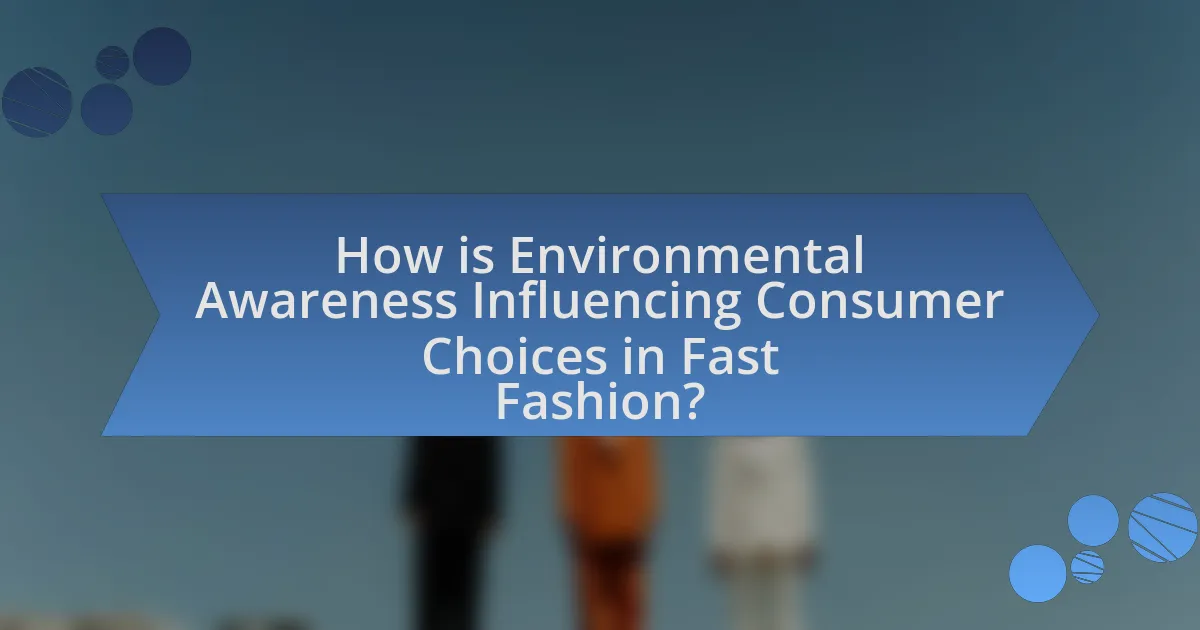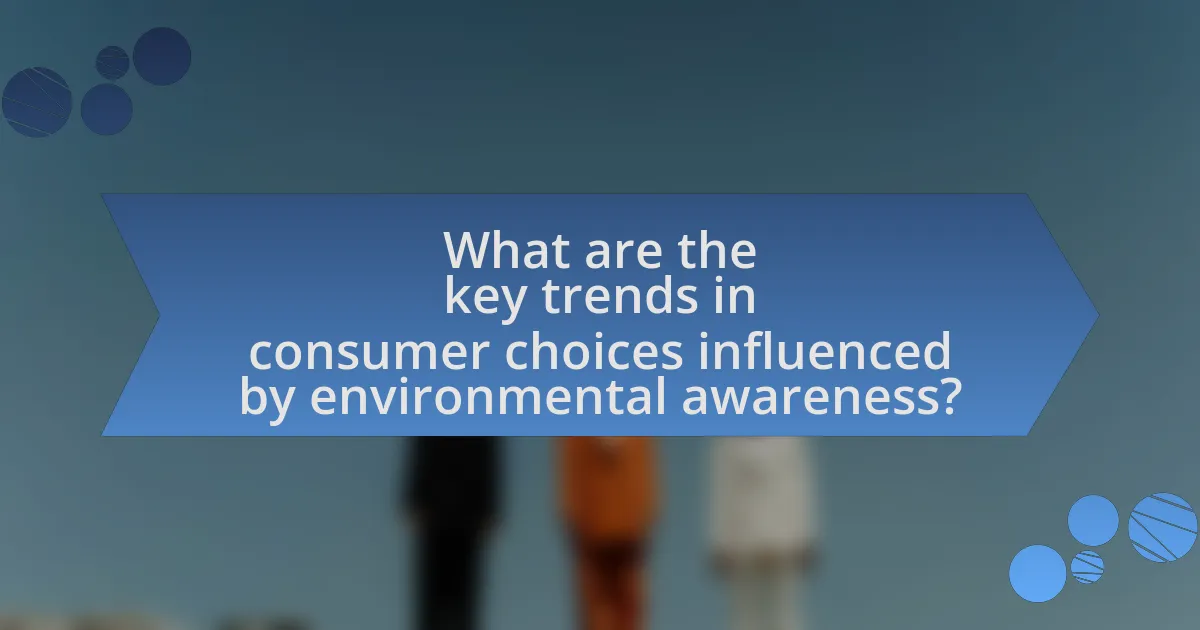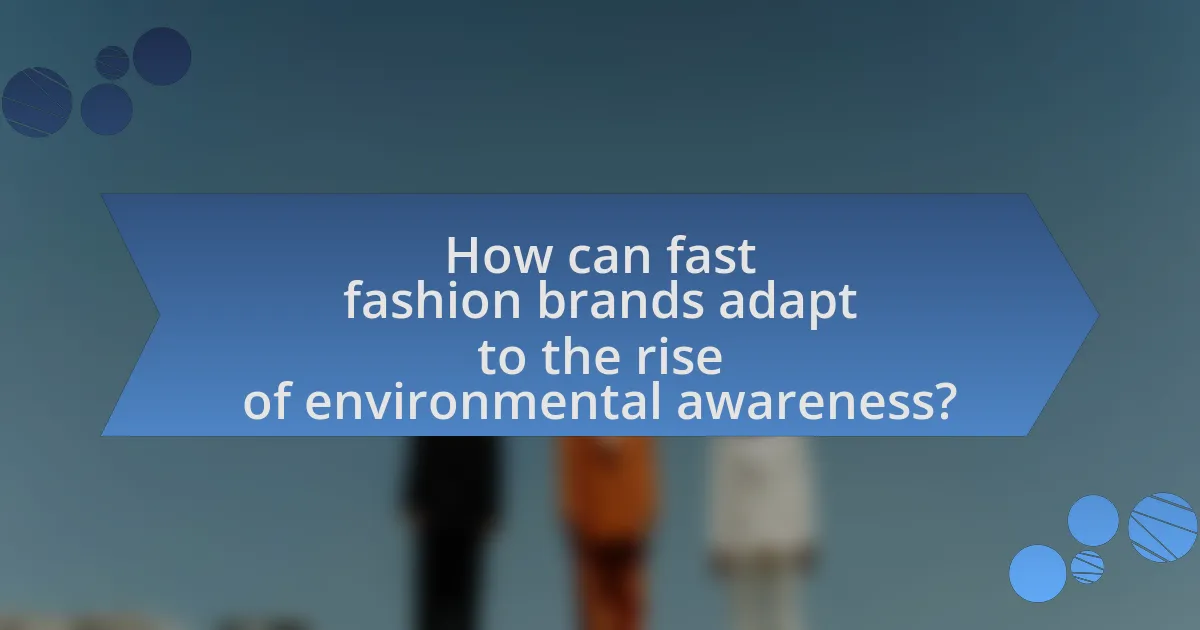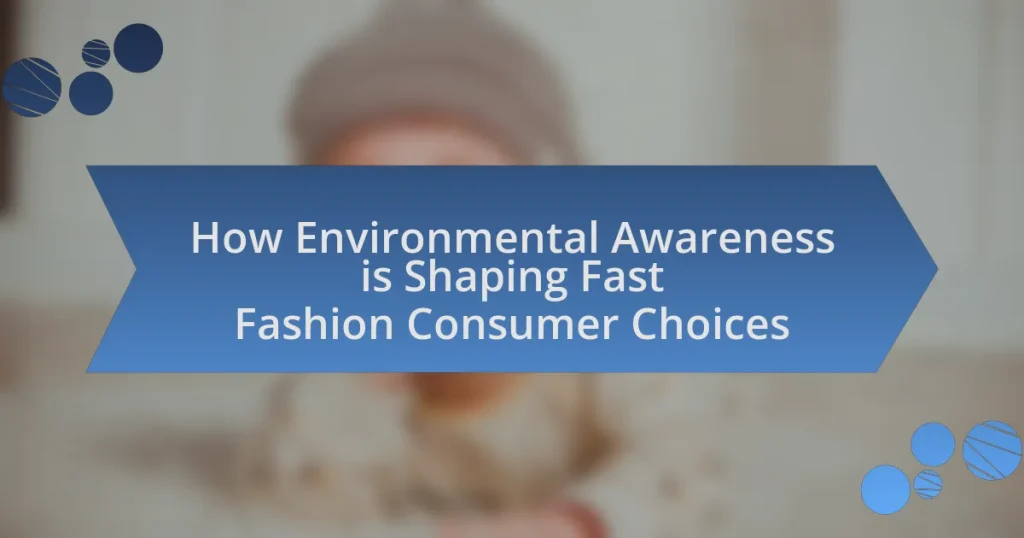The article examines how environmental awareness is influencing consumer choices in the fast fashion industry. It highlights the growing demand for sustainable and ethically produced clothing as consumers become more informed about the negative impacts of fast fashion, including pollution and waste. Key findings indicate that a significant percentage of consumers prioritize sustainability in their purchasing decisions, with many willing to pay more for eco-friendly brands. The article also discusses the role of education, media, and social movements in raising awareness, as well as the challenges fast fashion brands face in adapting to these consumer preferences. Additionally, it outlines practical steps consumers can take to make environmentally friendly choices and identifies criteria for evaluating the sustainability of fashion brands.

How is Environmental Awareness Influencing Consumer Choices in Fast Fashion?
Environmental awareness is significantly influencing consumer choices in fast fashion by driving demand for sustainable and ethically produced clothing. As consumers become more informed about the environmental impact of fast fashion, including issues like waste, pollution, and labor practices, they increasingly prefer brands that prioritize sustainability. For instance, a 2021 survey by McKinsey & Company found that 67% of consumers consider the use of sustainable materials important when making fashion purchases. This shift in consumer behavior is prompting fast fashion brands to adopt eco-friendly practices, such as using recycled materials and improving supply chain transparency, to meet the growing demand for responsible consumption.
What role does environmental awareness play in shaping consumer behavior?
Environmental awareness significantly influences consumer behavior by driving individuals to make more sustainable purchasing decisions. As consumers become increasingly informed about the environmental impacts of their choices, such as pollution and resource depletion associated with fast fashion, they tend to prefer brands that demonstrate eco-friendly practices. Research indicates that 66% of global consumers are willing to pay more for sustainable brands, highlighting a shift towards prioritizing environmental considerations in purchasing decisions. This trend is further supported by studies showing that consumers are more likely to support companies that engage in transparent sustainability efforts, thereby reinforcing the importance of environmental awareness in shaping consumer preferences and behaviors.
How do consumers perceive the environmental impact of fast fashion?
Consumers generally perceive the environmental impact of fast fashion as significantly negative. Research indicates that a majority of consumers are aware that fast fashion contributes to pollution, waste, and resource depletion. For instance, a survey conducted by McKinsey & Company found that 66% of respondents consider sustainability when making fashion purchases, highlighting a growing concern about the ecological footprint of their clothing choices. Additionally, studies show that fast fashion is responsible for 10% of global carbon emissions, further solidifying consumer awareness of its detrimental effects on the environment.
What factors contribute to increased environmental awareness among consumers?
Increased environmental awareness among consumers is primarily driven by education, media influence, and social movements. Education initiatives, such as school programs and community workshops, inform individuals about environmental issues, leading to a greater understanding of sustainability. Media coverage, including documentaries and news articles, highlights the impact of consumer choices on the environment, further raising awareness. Additionally, social movements, such as climate strikes and advocacy campaigns, mobilize public sentiment and encourage collective action towards sustainable practices. Research indicates that consumers exposed to these factors are more likely to adopt eco-friendly behaviors, as evidenced by a 2021 study published in the Journal of Consumer Research, which found that 70% of participants reported changing their purchasing habits after learning about environmental issues.
Why is environmental awareness becoming a priority for fast fashion consumers?
Environmental awareness is becoming a priority for fast fashion consumers due to increasing concerns about the negative impact of the fashion industry on the environment. Fast fashion is responsible for significant waste, with the Ellen MacArthur Foundation reporting that the equivalent of one garbage truck of textiles is landfilled or incinerated every second. Consumers are now more informed about issues such as pollution, resource depletion, and unethical labor practices, leading them to seek sustainable alternatives. This shift is further supported by studies indicating that 66% of global consumers are willing to pay more for sustainable brands, highlighting a growing demand for environmentally responsible practices in the fashion sector.
What are the consequences of fast fashion on the environment?
Fast fashion significantly harms the environment through increased waste, pollution, and resource depletion. The production of fast fashion garments leads to approximately 92 million tons of textile waste annually, as many items are discarded after only a few wears. Additionally, the industry is responsible for about 10% of global carbon emissions, contributing to climate change. Water pollution is another critical issue, with the dyeing process releasing toxic chemicals into waterways, affecting aquatic ecosystems and human health. Furthermore, fast fashion consumes vast amounts of water, with an estimated 2,700 liters required to produce a single cotton t-shirt, exacerbating water scarcity in many regions.
How does social media influence consumer awareness of environmental issues?
Social media significantly influences consumer awareness of environmental issues by facilitating the rapid dissemination of information and fostering community engagement around sustainability topics. Platforms like Instagram and Twitter allow users to share content related to environmental concerns, such as climate change and pollution, which raises awareness among their followers. For instance, a study by the Pew Research Center found that 69% of adults in the U.S. use social media, and among these users, a substantial portion engages with content related to environmental activism, leading to increased public discourse and awareness. This engagement often translates into consumer behavior changes, as individuals become more informed about the environmental impact of their purchases, particularly in fast fashion, where sustainability issues are prominent.

What are the key trends in consumer choices influenced by environmental awareness?
Key trends in consumer choices influenced by environmental awareness include a significant shift towards sustainable products, increased demand for transparency in supply chains, and a preference for second-hand or upcycled fashion. Consumers are increasingly prioritizing eco-friendly materials, with a 2021 survey indicating that 66% of global consumers are willing to pay more for sustainable brands. Additionally, brands that disclose their environmental impact and ethical practices are gaining favor, as 73% of millennials are willing to pay extra for sustainable offerings. The rise of thrift shopping and clothing rental services also reflects this trend, with the second-hand market projected to reach $64 billion by 2024, driven by environmentally conscious consumers seeking to reduce waste.
How are consumers shifting towards sustainable fashion alternatives?
Consumers are increasingly shifting towards sustainable fashion alternatives due to heightened environmental awareness and a desire for ethical consumption. This shift is evidenced by a 2021 survey from McKinsey & Company, which found that 67% of consumers consider the use of sustainable materials important when making fashion purchases. Additionally, the Global Fashion Agenda reported that 75% of consumers are willing to pay more for sustainable products, indicating a significant change in purchasing behavior. This trend reflects a growing recognition of the environmental impact of fast fashion, prompting consumers to seek brands that prioritize sustainability and ethical practices.
What types of sustainable fashion options are gaining popularity?
Sustainable fashion options gaining popularity include upcycled clothing, organic materials, and rental services. Upcycled clothing, which repurposes existing garments into new designs, has seen a rise in consumer interest due to its environmental benefits and unique styles. Organic materials, such as cotton and linen grown without harmful pesticides, are increasingly favored for their reduced ecological impact. Additionally, rental services allow consumers to access high-quality fashion without the commitment of ownership, promoting a circular economy. According to a 2021 report by McKinsey & Company, the rental fashion market is projected to grow significantly, reflecting a shift in consumer preferences towards sustainability.
How do consumers evaluate the sustainability of fashion brands?
Consumers evaluate the sustainability of fashion brands primarily through criteria such as transparency, material sourcing, production practices, and brand certifications. Transparency involves how openly brands communicate their supply chain practices and environmental impact, with 73% of consumers indicating they prefer brands that disclose their sustainability efforts. Material sourcing refers to the use of eco-friendly materials, with 66% of consumers willing to pay more for sustainable fabrics. Production practices encompass ethical labor conditions and reduced carbon footprints, which are increasingly important to consumers, as evidenced by a 2021 survey showing that 57% of consumers consider ethical labor practices when making purchasing decisions. Brand certifications, such as Fair Trade or Global Organic Textile Standard, serve as trusted indicators of sustainability, influencing 62% of consumers’ choices.
What impact does environmental awareness have on brand loyalty in fast fashion?
Environmental awareness significantly enhances brand loyalty in fast fashion. Consumers increasingly prefer brands that demonstrate sustainable practices, as evidenced by a 2021 survey indicating that 66% of global consumers are willing to pay more for sustainable brands. This shift in consumer behavior is driven by a growing recognition of the environmental impact of fast fashion, leading to a demand for transparency and ethical practices. Brands that actively promote eco-friendly initiatives, such as using recycled materials or reducing carbon footprints, tend to foster stronger emotional connections with consumers, resulting in increased loyalty and repeat purchases.
How do consumers’ values align with their purchasing decisions?
Consumers’ values significantly influence their purchasing decisions, particularly in the context of environmental awareness. Research indicates that consumers who prioritize sustainability are more likely to choose brands that demonstrate eco-friendly practices, such as using organic materials or implementing fair labor standards. For instance, a 2021 survey by McKinsey found that 67% of consumers consider the use of sustainable materials as a key factor in their buying choices. This alignment between values and purchasing behavior reflects a growing trend where ethical considerations drive consumer loyalty and brand preference in the fast fashion industry.
What strategies do brands use to appeal to environmentally conscious consumers?
Brands appeal to environmentally conscious consumers by implementing sustainable practices, such as using eco-friendly materials, promoting ethical labor practices, and adopting transparent supply chains. For instance, many brands now utilize organic cotton, recycled polyester, and biodegradable fabrics to reduce their environmental impact. Additionally, brands like Patagonia and Everlane emphasize their commitment to fair labor practices and transparency, showcasing their supply chain to build trust with consumers. Research indicates that 66% of consumers are willing to pay more for sustainable brands, highlighting the effectiveness of these strategies in attracting environmentally conscious shoppers.

How can fast fashion brands adapt to the rise of environmental awareness?
Fast fashion brands can adapt to the rise of environmental awareness by implementing sustainable practices in their production processes. This includes using eco-friendly materials, such as organic cotton or recycled polyester, which reduces the environmental impact of garment manufacturing. For instance, brands like H&M have introduced a Conscious Collection that features sustainable fabrics, demonstrating a commitment to environmental responsibility. Additionally, fast fashion companies can adopt circular economy principles by promoting recycling and upcycling initiatives, encouraging consumers to return used clothing for reuse or recycling. Research indicates that 66% of consumers are willing to pay more for sustainable brands, highlighting the market demand for environmentally conscious practices. By aligning their business models with these sustainable strategies, fast fashion brands can effectively respond to the growing consumer preference for environmentally friendly options.
What practices can fast fashion brands implement to become more sustainable?
Fast fashion brands can implement practices such as using sustainable materials, improving supply chain transparency, and adopting circular economy principles to become more sustainable. By sourcing organic cotton, recycled polyester, and other eco-friendly fabrics, brands can reduce their environmental impact. Additionally, enhancing supply chain transparency allows consumers to understand the sourcing and production processes, fostering trust and accountability. Implementing circular economy practices, such as take-back programs and recycling initiatives, can minimize waste and promote the reuse of materials. These practices are supported by research indicating that sustainable materials can significantly lower carbon emissions and resource consumption in the fashion industry.
How can brands effectively communicate their sustainability efforts to consumers?
Brands can effectively communicate their sustainability efforts to consumers by utilizing transparent messaging and engaging storytelling. Transparency involves providing clear, accessible information about sustainable practices, such as sourcing materials, production processes, and supply chain management. For instance, brands like Patagonia openly share their environmental impact reports, which detail their carbon footprint and initiatives for reducing waste. Engaging storytelling can create emotional connections; brands can highlight real-life stories of communities or ecosystems positively impacted by their sustainability efforts. Research indicates that 66% of consumers are willing to pay more for sustainable brands, demonstrating that effective communication can enhance consumer trust and loyalty.
What role does transparency play in consumer trust and brand reputation?
Transparency is crucial in building consumer trust and enhancing brand reputation. When brands openly share information about their practices, sourcing, and environmental impact, consumers are more likely to perceive them as credible and trustworthy. A study by Label Insight found that 94% of consumers are more likely to be loyal to a brand that offers complete transparency. This trust translates into a positive brand reputation, as consumers increasingly favor brands that align with their values, particularly regarding sustainability and ethical practices. Therefore, transparency not only fosters consumer loyalty but also strengthens a brand’s overall reputation in a competitive market.
What challenges do fast fashion brands face in addressing environmental concerns?
Fast fashion brands face significant challenges in addressing environmental concerns primarily due to their business model, which prioritizes rapid production and low costs over sustainability. This model leads to high levels of waste, as the industry generates approximately 92 million tons of textile waste annually, according to the United Nations. Additionally, fast fashion brands struggle with supply chain transparency, making it difficult to ensure sustainable practices throughout their production processes. The reliance on cheap materials often results in environmentally harmful practices, such as excessive water usage and pollution. Furthermore, consumer demand for low prices and quick turnaround times complicates efforts to implement eco-friendly initiatives, as these often require higher costs and longer production timelines.
How do economic factors influence the adoption of sustainable practices?
Economic factors significantly influence the adoption of sustainable practices by affecting the cost and accessibility of sustainable options. When consumers perceive sustainable products as more expensive, they may opt for cheaper, less sustainable alternatives, thereby hindering the adoption of eco-friendly practices. For instance, a study by the World Economic Forum found that 66% of consumers are willing to pay more for sustainable brands, but only if the price difference is manageable. Additionally, economic incentives such as subsidies for sustainable businesses or tax breaks for consumers purchasing eco-friendly products can encourage the adoption of sustainable practices. These financial mechanisms can lower the barriers to entry for both consumers and businesses, promoting a shift towards sustainability in the fast fashion industry.
What are the potential trade-offs for brands transitioning to sustainable models?
Brands transitioning to sustainable models face potential trade-offs including increased production costs, supply chain complexities, and potential loss of customer base. Increased production costs arise from sourcing sustainable materials and implementing eco-friendly processes, which can lead to higher retail prices. Supply chain complexities involve the need for new partnerships and logistics to ensure sustainability throughout the production cycle. Additionally, brands may risk alienating price-sensitive consumers who prioritize affordability over sustainability. According to a 2021 McKinsey report, 67% of consumers consider sustainability when making a purchase, indicating a growing market for sustainable products, but also highlighting the challenge of balancing cost and consumer expectations.
What practical steps can consumers take to make more environmentally friendly choices in fast fashion?
Consumers can make more environmentally friendly choices in fast fashion by prioritizing sustainable brands, opting for second-hand clothing, and practicing mindful consumption. Sustainable brands often use eco-friendly materials and ethical production methods, which reduce environmental impact. Purchasing second-hand clothing extends the lifecycle of garments and decreases demand for new production, which is responsible for significant waste and pollution. Mindful consumption involves buying only what is necessary, reducing impulse purchases, and choosing quality over quantity, which can lead to a decrease in overall textile waste. According to the Ellen MacArthur Foundation, the fashion industry is responsible for 10% of global carbon emissions, highlighting the importance of these consumer choices in mitigating environmental harm.
How can consumers identify truly sustainable brands?
Consumers can identify truly sustainable brands by examining their transparency, certifications, and supply chain practices. Brands that openly share information about their sourcing, production processes, and environmental impact demonstrate a commitment to sustainability. Certifications from recognized organizations, such as Fair Trade, Global Organic Textile Standard (GOTS), or the Forest Stewardship Council (FSC), provide credible evidence of a brand’s sustainable practices. Additionally, brands that prioritize ethical labor practices and minimize waste in their supply chains are more likely to be genuinely sustainable. Research indicates that consumers increasingly prefer brands that align with their values, with 66% of global consumers willing to pay more for sustainable brands, highlighting the importance of informed choices in the marketplace.
What are some tips for reducing waste in fast fashion consumption?
To reduce waste in fast fashion consumption, consumers should prioritize buying second-hand clothing, which extends the lifecycle of garments and minimizes landfill contributions. Research indicates that purchasing second-hand can reduce carbon emissions by up to 82% compared to buying new items. Additionally, consumers can adopt a minimalist wardrobe approach, focusing on versatile pieces that can be mixed and matched, thereby decreasing the overall quantity of clothing needed. Implementing a “one in, one out” policy, where a new item is only purchased if an old one is discarded or donated, further helps to manage clothing volume. Lastly, supporting sustainable brands that prioritize eco-friendly materials and ethical production practices can significantly contribute to reducing waste in the fast fashion industry.















